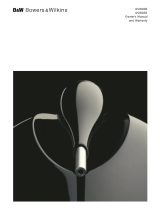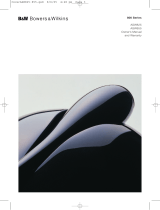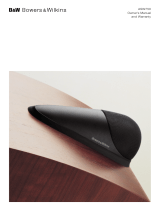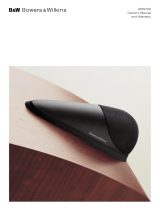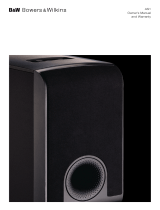
What the subwoofer does
Application: Home Theatre
The primary function of the subwoofer is to
reproduce signals from the Low Frequency
Effects (LFE) channel. In addition, the
processor may be configured to divert the
low bass portion of some or all of the other
channels and add it to the LFE information
by configuring those speakers to 'small' in
the processor set-up procedure.
Application: 2-channel audio
The subwoofer is used to extend the bass
response beyond that provided by the
satellite speakers. Best results are obtained
if the satellite speakers are run full range as
normal directly from the power amplifier.
The subwoofer low-pass filter is then set so
that its output rises as that of the satellite
speakers falls naturally.
Positioning the subwoofer
Because the subwoofer produces only low-
frequency sounds, positioning is less critical
in some respects compared to full-range
speakers. Directional information is much
less precise and you have more choice
where to place the speakers to good effect.
This said, best results are obtained if the
subwoofer is placed between the satellite
speakers or in the vicinity of one of them. If
you use two subwoofers, it is best to put
one near each satellite speaker.
Placing the subwoofer behind the listeners,
even in surround sound installations,
generally gives inferior imaging, but may be
an acceptable compromise if domestic
considerations dictate.
As with all speakers, the proximity of room
boundaries affects the sound. Bass is
generally increased as more surfaces come
into close proximity with the speakers.
Unlike full-range speakers, however, you
can always restore the correct overall
system balance by adjusting the volume
level of the subwoofer. The more boost you
get from the room, the less hard the
speaker has to work; but there is a down
side. Corner positions often excite more
low-frequency room resonances, making
the bass more uneven with frequency.
There is no substitute for experiment as all
rooms behave differently, so try the
subwoofer in a variety of positions before
making a final decision. A piece of music
with a bass line ascending or descending
the musical scale is useful for assessing the
smoothness of the bass response. Listen
for exaggerated or quiet notes. Having a
separate subwoofer does enable you to
optimise for room resonances
independently from siting the satellite
speakers for best imaging.
If the subwoofer is to be used in a confined
space (eg in custom furniture), the space
must be ventilated to allow sufficient air to
circulate and cool the unit. Ask your dealer
for advice.
Electrical connections
Disconnect all sound system equipment
from the power supply until the signal
connections have been made and checked.
This avoids the risk of damage whilst
connections are made or broken.
Application: Home Theatre (figure 4)
Connect the subwoofer LINE IN socket (1)
to the line-level output of the processor
marked LFE or SUBWOOFER, using a
suitable coaxial interconnect cable. If using
more than one subwoofer, daisy chain them
together by connecting the LINK OUT
socket (2) of the first to the LINE IN socket
(1) of the next.
Application: 2-channel audio
For 2-channel operation, use speaker level
rather than line level connections. The
subwoofer presents a high impedance load
to the stereo power amplifier and takes
very little current, so may be connected in
parallel with the main speakers with no
adverse effects.
Using one subwoofer (figure 5)
The left and right channels are both
connected and summed in the subwoofer
amplifier.
Using the cable provided with the
subwoofer, insert the rectangular RJ11 plug
into the SPEAKER LEVEL IN socket (3) on
the underside of the subwoofer. Connect
the inner cores to the amplifier outputs as
follows:
Yellow – Left +
Green – Left –
Red – Right +
Black – Right –
Using two subwoofers (figure 6)
If one subwoofer can be placed close to the
left speaker and the other close to the right
speaker, stereo separation is best
maintained by connecting each subwoofer
to a separate output channel of the amplifier.
Using the cables provided with the
subwoofers, insert the rectangular RJ11
plug into the SPEAKER IN socket (3) on the
underside of each subwoofer. Connect the
inner cores to the stereo power amplifier
outputs as follows:
Left subwoofer:
Yellow – Left +
Green – Left –
Red – Unconnected
Black – Unconnected
Right subwoofer:
Yellow – Unconnected
Green – Unconnected
Red – Right +
Black – Right –
Warning:
The unconnected inner cores
must be properly insulated to
prevent short circuits and
possible damage to the power
amplifiers.
If the subwoofers cannot be placed close
to the main speakers, better results may be
obtained by feeding the left and right
channels to both subwoofers, connecting
both subwoofers as shown in figure 5 and
described above in the section "Using one
subwoofer".
Using more than one subwoofer
Using more than one unit in a single
installation can improve performance in the
following ways:
• Maintain stereo separation to the
lowest frequencies.
• Cope with larger listening rooms.
• Enable greater maximum sound output
– often useful for effectively
reproducing special effects in Home
Theatre applications.
• Smooth out the effects of low-
frequency room resonances.
Double-check the connections
Before auditioning the sound quality of your
new installation and fine-tuning it, double-
check the connections. All too often, users
complain that they cannot get a decent
sound however they set the controls, only
to discover something has been wrongly
connected. Make sure that:
• The phasing is correct – there should
be no positive to negative connections
to any of the speakers. If something is
out of phase you may get a fuzzy
sound with an imprecise and floating
image, a lack of bass or a combination
of the two.
• There are no left to right mix-ups – this
can result, for example, in the
orchestra being the wrong way round
or, more disastrously, sounds on your
Home Theatre going in the opposite
direction to the action on the screen.
Switching on and off
We recommend that you switch the
subwoofer on after any equipment feeding
signals to it. Similarly, when switching off,
switch the subwoofer off first.
The MODE standby/auto/on switch (10)
does not isolate the amplifier completely
from the power supply. It maintains a low-
power input to an auxiliary sensing circuit.
The switch (10) operates as follows:
O On:
With the switch in this position, the
amplifier remains permanently on, and the
light glows green.
A Auto:
On first switching the subwoofer to Auto,
the amplifier goes into standby mode, and
the light glows red. When an input signal is
detected, the amplifier automatically
becomes fully active and the light glows
green. After a period of about 5 minutes
without an input signal, the amplifier
automatically reverts to standby mode and
the light glows red.
s Standby:
In this position, the amplifier is in permanent
standby, and the light glows red.
If, when set to Auto, the subwoofer should
repeatedly go into standby mode when
playing programme via the LINE IN socket,
try reducing the volume setting on the
subwoofer and restoring the balance by
increasing the subwoofer output of the
processor.
If the subwoofer is to be out of use for an
extended period of time, we recommend
you isolate it from the power supply by
removing the plug from the power socket.
4









